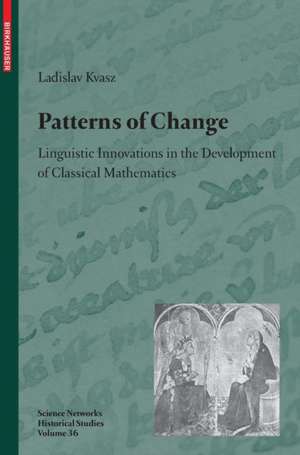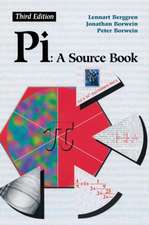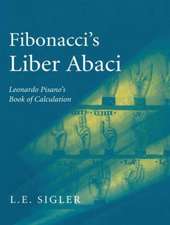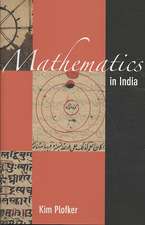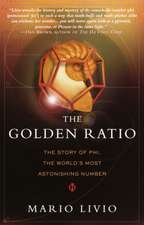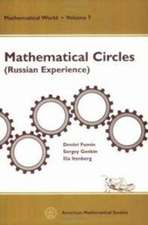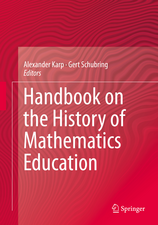Patterns of Change: Linguistic Innovations in the Development of Classical Mathematics: Science Networks. Historical Studies, cartea 36
Autor Ladislav Kvaszen Limba Engleză Hardback – 17 iul 2008
Din seria Science Networks. Historical Studies
- 18%
 Preț: 796.31 lei
Preț: 796.31 lei - 15%
 Preț: 652.49 lei
Preț: 652.49 lei - 18%
 Preț: 787.15 lei
Preț: 787.15 lei -
 Preț: 385.25 lei
Preț: 385.25 lei -
 Preț: 489.30 lei
Preț: 489.30 lei - 15%
 Preț: 476.75 lei
Preț: 476.75 lei -
 Preț: 389.31 lei
Preț: 389.31 lei - 15%
 Preț: 699.59 lei
Preț: 699.59 lei - 15%
 Preț: 660.37 lei
Preț: 660.37 lei - 15%
 Preț: 531.59 lei
Preț: 531.59 lei - 24%
 Preț: 909.27 lei
Preț: 909.27 lei -
 Preț: 396.24 lei
Preț: 396.24 lei - 18%
 Preț: 903.17 lei
Preț: 903.17 lei -
 Preț: 382.36 lei
Preț: 382.36 lei -
 Preț: 395.25 lei
Preț: 395.25 lei - 15%
 Preț: 647.73 lei
Preț: 647.73 lei - 15%
 Preț: 702.87 lei
Preț: 702.87 lei - 15%
 Preț: 674.74 lei
Preț: 674.74 lei - 15%
 Preț: 655.60 lei
Preț: 655.60 lei - 15%
 Preț: 650.19 lei
Preț: 650.19 lei - 15%
 Preț: 644.82 lei
Preț: 644.82 lei - 15%
 Preț: 646.62 lei
Preț: 646.62 lei - 18%
 Preț: 1119.08 lei
Preț: 1119.08 lei - 18%
 Preț: 1135.46 lei
Preț: 1135.46 lei - 20%
 Preț: 595.48 lei
Preț: 595.48 lei - 20%
 Preț: 596.59 lei
Preț: 596.59 lei - 20%
 Preț: 567.63 lei
Preț: 567.63 lei - 15%
 Preț: 639.37 lei
Preț: 639.37 lei -
 Preț: 399.12 lei
Preț: 399.12 lei - 18%
 Preț: 1390.11 lei
Preț: 1390.11 lei -
 Preț: 361.03 lei
Preț: 361.03 lei - 18%
 Preț: 1395.63 lei
Preț: 1395.63 lei - 15%
 Preț: 642.36 lei
Preț: 642.36 lei - 15%
 Preț: 648.24 lei
Preț: 648.24 lei - 15%
 Preț: 649.06 lei
Preț: 649.06 lei -
 Preț: 392.37 lei
Preț: 392.37 lei
Preț: 649.06 lei
Preț vechi: 763.60 lei
-15% Nou
Puncte Express: 974
Preț estimativ în valută:
124.19€ • 130.14$ • 102.67£
124.19€ • 130.14$ • 102.67£
Carte tipărită la comandă
Livrare economică 12-26 aprilie
Preluare comenzi: 021 569.72.76
Specificații
ISBN-13: 9783764388393
ISBN-10: 3764388390
Pagini: 264
Ilustrații: XVIII, 262 p.
Dimensiuni: 170 x 244 x 19 mm
Greutate: 0.66 kg
Ediția:2008
Editura: Birkhäuser Basel
Colecția Birkhäuser
Seria Science Networks. Historical Studies
Locul publicării:Basel, Switzerland
ISBN-10: 3764388390
Pagini: 264
Ilustrații: XVIII, 262 p.
Dimensiuni: 170 x 244 x 19 mm
Greutate: 0.66 kg
Ediția:2008
Editura: Birkhäuser Basel
Colecția Birkhäuser
Seria Science Networks. Historical Studies
Locul publicării:Basel, Switzerland
Public țintă
ResearchCuprins
Preface.- Introduction.- Re-codings as the first pattern of change in mathematics.- Historical description of re-codings.- Philosophical reflections on re-codings.- Relativizations as the second pattern of change in mathematics.- A Historical description of relativizations in synthetic geometry.- Historical description of relativizations in algebra.- Philosophical reflections on relativizations.- Re-formulations as a third pattern of change in mathematics.- Re-formulations and concept-formation.- Re-formulations and problem-solving.- Re-formulations and theory-building.- Mathematics and change.- The question of revolutions in mathematics (Kuhn).- The question of mathematical research programs (Lakatos).- The question of stages of cognitive development (Piaget).- Notes.- Bibliography.
Recenzii
From the reviews:
“This is a book on the history and philosophy of mathematics interpreted as a sequence of linguistic innovations. … Kvasz has succeeded in producing a book which synthesizes over a quarter of century of his contributions to a linguistic approach to the history and philosophy of mathematics. The book should prove of interest not only to mathematicians. It suggests new directions for the analysis of changes … resulting from cultural encounters. … The book also has explicit references … to obstacles in mathematics education.” (U. D’Ambrosio, Mathematical Reviews, Issue 2009 k)
“In this book the author expounds his ‘linguistic approach’ for reconstructing the development of mathematical disciplines from a philosophical and historical point of view. … Kvasz’ approach provides an interesting tool for philosophers and historians which should be further discussed and applied.” (Hans Fischer, Zentralblatt MATH, Vol. 1153, 2009)
“This is a book on the history and philosophy of mathematics interpreted as a sequence of linguistic innovations. … Kvasz has succeeded in producing a book which synthesizes over a quarter of century of his contributions to a linguistic approach to the history and philosophy of mathematics. The book should prove of interest not only to mathematicians. It suggests new directions for the analysis of changes … resulting from cultural encounters. … The book also has explicit references … to obstacles in mathematics education.” (U. D’Ambrosio, Mathematical Reviews, Issue 2009 k)
“In this book the author expounds his ‘linguistic approach’ for reconstructing the development of mathematical disciplines from a philosophical and historical point of view. … Kvasz’ approach provides an interesting tool for philosophers and historians which should be further discussed and applied.” (Hans Fischer, Zentralblatt MATH, Vol. 1153, 2009)
Textul de pe ultima copertă
This book offers a reconstruction of linguistic innovations in the history of mathematics; innovations which changed the ways in which mathematics was done, understood and philosophically interpreted. It argues that there are at least three ways in which the language of mathematics has been changed throughout its history, thus determining the lines of development that mathematics has followed.
One of these patterns of change, called a re-coding, generates two developmental lines. The first of them connecting arithmetic, algebra, differential and integral calculus and predicate calculus led to a gradual increase of the power of our calculating tools, turning difficult problems of the past into easy exercises. The second developmental line connecting synthetic geometry, analytic geometry, fractal geometry, and set theory led to a sophistication of the ways we construct geometrical objects, altering our perception of form and increasing our sensitivity to complex visual patterns.
Another important pattern of change, called relativization, is illustrated by the development of synthetic geometry, connecting Euclid’s geometry, projective geometry, non-Euclidean geometry, and Klein’s Erlanger Programm up to Hilbert’s Grundlagen der Geometrie. In this development the notions of space and geometric object underwent deep and radical changes culminating in the liberation of objects from the supremacy of space and so bringing to existence geometric objects which space would never tolerate.
The book offers tools of analysis by means of which scholars and students of the history and philosophy of mathematics can attain better understanding of the various changes, which the subject of their study underwent in the course of history. The book brings also important insights for mathematics education connecting growth of language with the development of mathematical thought.
One of these patterns of change, called a re-coding, generates two developmental lines. The first of them connecting arithmetic, algebra, differential and integral calculus and predicate calculus led to a gradual increase of the power of our calculating tools, turning difficult problems of the past into easy exercises. The second developmental line connecting synthetic geometry, analytic geometry, fractal geometry, and set theory led to a sophistication of the ways we construct geometrical objects, altering our perception of form and increasing our sensitivity to complex visual patterns.
Another important pattern of change, called relativization, is illustrated by the development of synthetic geometry, connecting Euclid’s geometry, projective geometry, non-Euclidean geometry, and Klein’s Erlanger Programm up to Hilbert’s Grundlagen der Geometrie. In this development the notions of space and geometric object underwent deep and radical changes culminating in the liberation of objects from the supremacy of space and so bringing to existence geometric objects which space would never tolerate.
The book offers tools of analysis by means of which scholars and students of the history and philosophy of mathematics can attain better understanding of the various changes, which the subject of their study underwent in the course of history. The book brings also important insights for mathematics education connecting growth of language with the development of mathematical thought.
Caracteristici
Focuses on changes of language in the history of mathematics Introduces exact tools of formal logic for the reconstruction of the historical development of the language of mathematics Offers two rather universal patterns of development Includes supplementary material: sn.pub/extras
